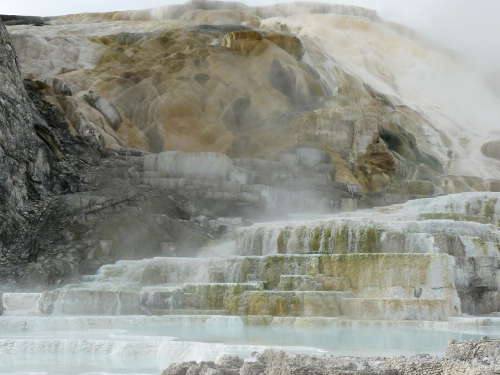 Location Taken: Yellowstone National Park, Wyoming
Location Taken: Yellowstone National Park, Wyoming
Time Taken: October 2012
The Mammoth Hot Springs sure do live up to their name. They are a massive set of geothermic terraces, layered one on top of each other over the years as the build-up of new material changes where the best place for the water to escape the ground is located.
This particular section is at the lowest level of the hot springs, right by the town that sprung up as a resort based around the springs. The water cascading here goes into a stream that runs right through the middle of town. It’s no longer a town where people really live, the old buildings having been converted into upscale visitor’s attractions for the National Park.
It’s very easy to tell where the hot springs have been active most recently. The travertine rock that permeates the water and is deposited when it cools degrades rather quickly when it’s no longer being renewed. The brilliant white of pure travertine quickly turns into a mottled dark grey as it’s exposed to wind and rain and time. It also takes on the colors of impurities rather well, as seen in the brilliant reds and browns of this cascade.
Perhaps the most interesting thing about terraced hot springs like this is you can tell the way water has flowed in the past. Areas where the water is moving quickly downhill, you get that bumpy appearance of the upper part of the picture. Areas where the water slowed down and perhaps even stopped, terraces form. The edges of the pool or stream dry out faster and deposit more material, leading to a rim forming around the pool. And it just builds up the edge of the pool as the slow-moving water goes over the edge, briefly forming a very thin (and easily evaporated) area of water. And, of course, areas that aren’t part of the current water system age into the grey regions.
